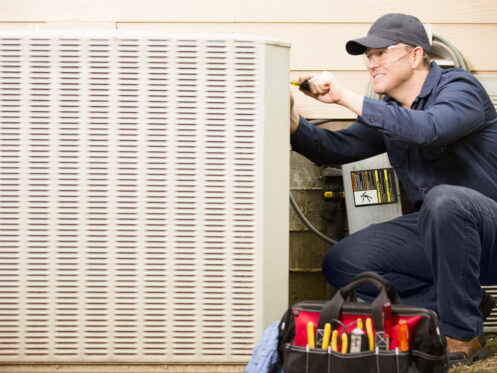As spring rolls around, you will find yourself using your air conditioning unit more consistently. A thorough once-over on your AC will ensure it runs more efficiently when the warm weather hits, ensuring your home is comfortable while saving you money on utility bills. Spring is undoubtedly the perfect time to clean and ensure your AC unit is in top form so you can avoid an expensive breakdown during the dog days of summer.
Maintain Clearance Around the Condenser
Remove the cover if you have one to winterize your AC’s outdoor unit. It needs to be thoroughly washed and hung to dry before being stored to be ready for next year.
Sweep away any debris, such as leaves, trash, and sticks that may have accumulated around the condenser. Additionally, pull any weeds that may have started to grow. You may also have to trim tree branches, bushes, or any other landscaping close to the unit. Keep in mind that it needs about 2 feet of clearance at its sides and top. This space will ensure proper airflow to the condenser, which can increase its efficiency and result in lower cooling costs.
Take note if your condenser tilts to one side because the ground may have shifted during winter. An uneven unit can cause problems, such as oil not getting to moving parts that need lubrication. An HVAC technician can level your unit. You should not do this yourself because you risk bending the coolant lines, which may cause a refrigerant leak.
Clean the Condenser Coil
An expertly trained technician will safely and effectively clean your condenser’s coils. Your HVAC technician will turn the power off to your unit before cleaning it for safety. To prevent damage, they will also ensure the condenser coil is completely dry before turning the AC back on.
After cleaning the coil, they will straighten any bent condenser fins. They help the unit release heat that has been collected from your house during the cooling process. A professional has the know-how and tools to straighten the fins with the gentleness it requires to avoid causing any further damage.
Clean Evaporator Coil in the Indoor Unit
The evaporator coil, made of copper tubing, is found in your indoor air handling unit and is directly involved in the heat exchange process. It absorbs heat from the air in your home. When dust and dirt accumulate on it, the buildup reduces the coil’s available surface area, reducing its heat-absorbing capacity. The lowered cooling capacity forces your air conditioning unit to run longer, leading to higher energy consumption and increased wear on your AC.
Another issue is that ice or frost may build up on your evaporator coil if it gets too dirty. When the evaporator coil doesn’t absorb enough heat, the refrigerant will become too cold, causing the moisture produced during the cooling process to condense on the coil, leading to a frozen unit.
A professional will use compressed air to clean the coils if the buildup is mild. On the other hand, they will need to use a cloth or soft brush to remove heavy dust buildup gently. As with the coils on the outdoor unit, cleaning evaporator coils requires careful handling, from removing the access panel to wiping down the coils.
Change or Clean the Air Filter
A dirty enough air filter is ineffective at preventing dust, dirt, hairs, allergens, and other particles from being recirculated within your spaces. If you have a reusable filter, then you’d only need to clean it. Changing or cleaning the air filter will allow you to continue enjoying great indoor air quality. Additionally, a clean air filter will improve your HVAC system’s energy efficiency since the AC will not have to work as hard to push air through your system.
Experts suggest that disposable air filters be changed at least every three months, while the reusable kind needs to be washed once a month. However, you may have to clean or replace your HVAC air filter more often. Factors like having pets who shed and how many people live in your house affect how quickly it gets dirty. Many homeowners inspect their filters monthly to ensure they are in good condition.
While a standard air filter should do fine for most homes, you will want to get a filter with a higher MERV rating if any family members have allergies. Keep in mind that this type of filter will need to be changed more often because it captures more airborne pollutants. You also do not want to get one with too high a MERV rating because it may restrict proper airflow to your cooling system. An HVAC professional can recommend a filter that will work well with your system while providing enhanced air filtration.
Clean the Indoor Vents and Ducts
Dust or grime coating your indoor supply and return vents can negatively affect your AC’s performance and indoor air quality. Opening and cleaning all the vents as part of your spring cleaning will have overall benefits, ensuring maximum energy efficiency and comfort levels. You will need a screwdriver to remove the vent covers.
You can use a vacuum to remove large debris. Next, wipe the grills down with a soapy cloth. They can be soaked in warm water and dish soap for more stubborn grime. A stiff brush is effective for getting them clean. While your vent covers dry, you can vacuum inside the vents up to where your ductwork starts.
After replacing the vent covers, ensure they are in the open position so that your cooling system delivers conditioned air evenly throughout your house. You should also check that rugs, furniture, or other objects do not block the vents.
In addition to cleaning the vents, you can trust a trained professional to inspect and clean your ducts. During ductwork cleaning, the technician will identify issues with your ducts, including gaps, leaks, and bent sections. They will also balance the ductwork to improve its overall efficiency.
If the professional finds issues, they will recommend solutions. These solutions may include sealing your ductwork and replacing damaged ducts. They may also recommend increasing the insulation around ducts in areas like your attack and crawl spaces to reduce cooling loss.
Clean the Condensate Drainage System
During the cooling process, your air conditioner removes humidity from your home. The moisture produced drains outside through the condensate line after being captured in the drain pan. A clog in the line can cause water to back up in your air conditioner, possibly resulting in a puddle of water and damage to the system. As part of AC maintenance, a professional will clear any clogs in the drainage line and clean the drain pan.
Contact the Professionals
At Plumbing, Cooling & Electrical Nerds, we have been serving the residents of Bonita Springs, FL and the surrounding areas since 2007. We install, maintain, and repair heating and cooling systems. Additionally, we are indoor air quality experts and provide ductwork services. Contact us today to schedule an appointment with one of our expert HVAC technicians.

